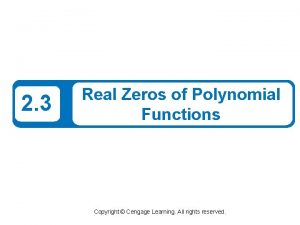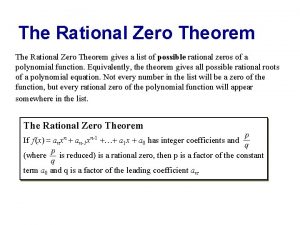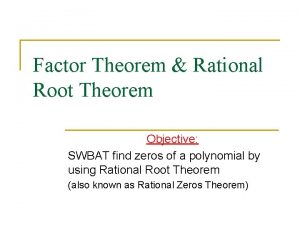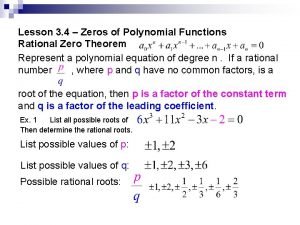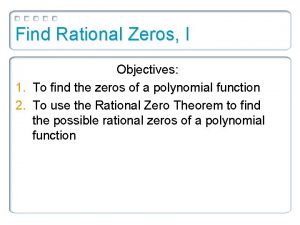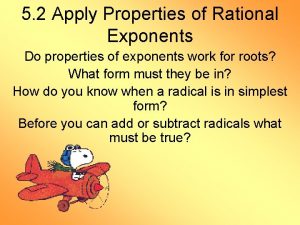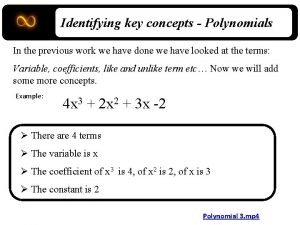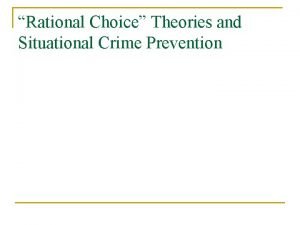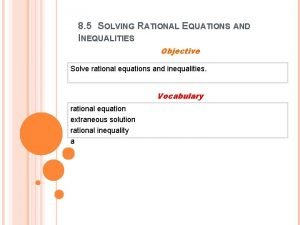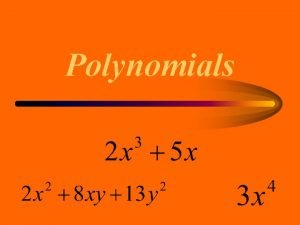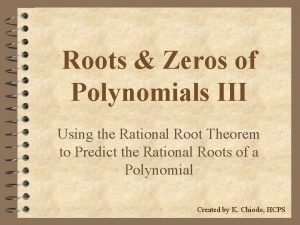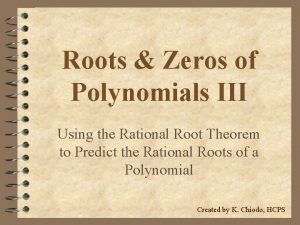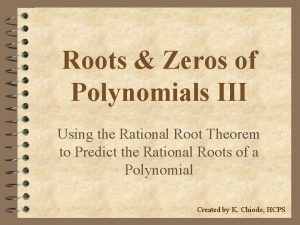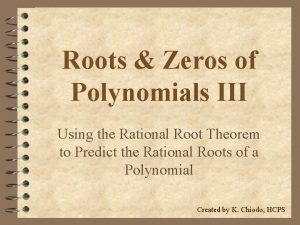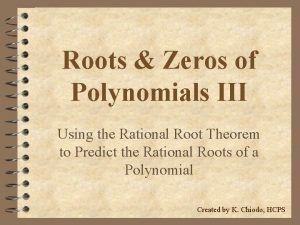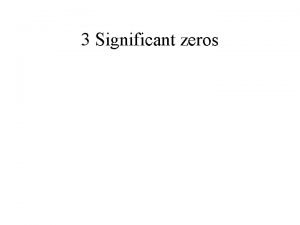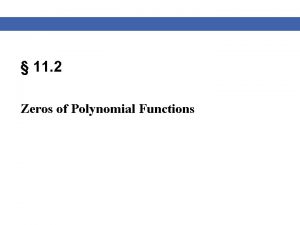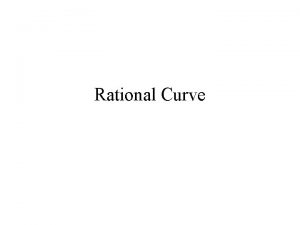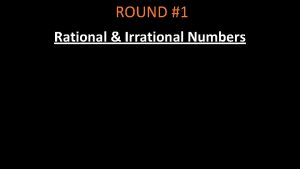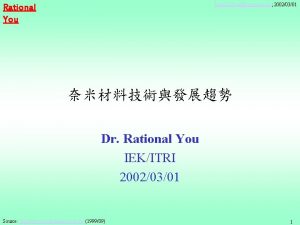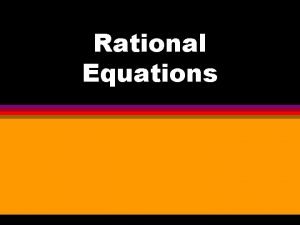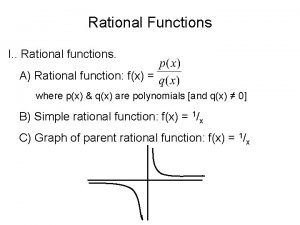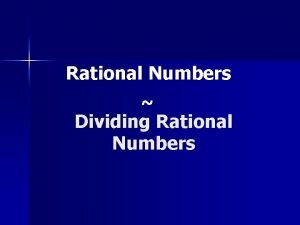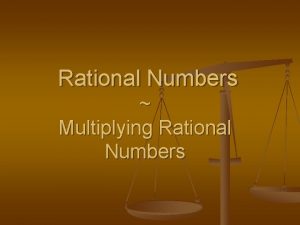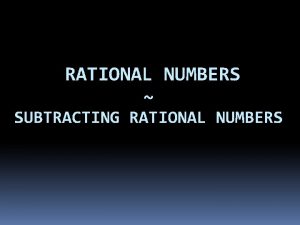Zeros of Polynomials Concepts 1 Apply the Rational




































- Slides: 36

Zeros of Polynomials

Concepts 1. Apply the Rational Zero Theorem 2. Apply the Fundamental Theorem of Algebra 3. Apply Descartes’ Rule of Signs 4. Find Upper and Lower Bounds

Apply the Rational Zero Theorem:

Apply the Rational Zero Theorem

Example 1: List all possible rational zeros of


Example 2: Find the zeros and their multiplicities.

Example 2 continued:

Example 3: Find the zeros and their multiplicities.




Concepts 1. Apply the Rational Zero Theorem 2. Apply the Fundamental Theorem of Algebra 3. Apply Descartes’ Rule of Signs 4. Find Upper and Lower Bounds

Apply the Fundamental Theorem of Algebra: If f (x) is a polynomial of degree n ≥ 1 with complex coefficients, then f (x) has at least one complex zero.

Apply the Fundamental Theorem of Algebra Linear Factorization Theorem:

Apply the Fundamental Theorem of Algebra Conjugate Zeros Theorem: If f (x) is a polynomial with real coefficients and if a + bi (b ≠ 0) is a zero of f (x) then its conjugate a – bi is also a zero of f(x).

Apply the Fundamental Theorem of Algebra Number of Zeros of a Polynomial: If f (x) is a polynomial of degree n ≥ 1 with complex coefficients, then f (x) has exactly n complex zeros provided that each zero is counted by its multiplicity.

Example 4: Given that is a zero of find the remaining zeros and factor as a product of linear factors.

Example 4 continued:

Example 5: Given that is one solution to , find the remaining solutions.

Example 5 continued:


Example 6: Find a polynomial f (x) of lowest degree with zeros of 3 i and 2 (multiplicity 2).

Example 7: Find a polynomial p(x) of degree 3 with zeros – 2 i and 4. The polynomial must also satisfy the condition that p(0) = 32.


Concepts 1. Apply the Rational Zero Theorem 2. Apply the Fundamental Theorem of Algebra 3. Apply Descartes’ Rule of Signs 4. Find Upper and Lower Bounds

Apply Descartes’ Rule of Signs Descartes' Rule of Signs: Let f (x) be a polynomial with real coefficients and a nonzero constant term. Then, The number of positive real zeros is either the same as the number of sign changes in f (x) or less than the number of sign changes in f (x) by a positive even integer. The number of negative real zeros is either the same as the number of sign changes in f (–x) or less than the number of sign changes in f (–x) by a positive even integer.

Example 8: Determine the number of possible positive and negative real zeros. Number of possible positive real zeros Number of possible negative real zeros Number of imaginary zeros Total (including multiplicities)



Concepts 1. Apply the Rational Zero Theorem 2. Apply the Fundamental Theorem of Algebra 3. Apply Descartes’ Rule of Signs 4. Find Upper and Lower Bounds

Find Upper and Lower Bounds A real number b is called an upper bound of the real zeros of a polynomial if all real zeros are less than or equal to b. A real number a is called a lower bound of the real zeros of a polynomial if all real zeros are greater than or equal to a.

Find Upper and Lower Bounds Let f (x) be a polynomial of degree n ≥ 1 with real coefficients and a positive leading coefficient. Further suppose that f (x) is divided by (x – c). 1. If c > 0 and if both the remainder and the coefficients of the quotient are nonnegative, then c is an upper bound for the real zeros of f (x). 2. If c < 0 and the coefficients of the quotient and the remainder alternate in sign (with 0 being considered either positive or negative as needed), then c is a lower bound for the real zeros of f.

Example 9: Given , show that 4 is an upper bound and – 2 is a lower bound for the real zeros.


 Rational zeros vs real zeros
Rational zeros vs real zeros Cross apply vs outer apply
Cross apply vs outer apply 5-2 polynomials linear factors and zeros form g
5-2 polynomials linear factors and zeros form g Rational zero theorem
Rational zero theorem What is the rational root theorem
What is the rational root theorem Possible rational roots calculator
Possible rational roots calculator Finding possible rational zeros
Finding possible rational zeros How to find the zeros of a function
How to find the zeros of a function How to find rational zeros
How to find rational zeros Polynomials in everyday life
Polynomials in everyday life Property of rational exponents
Property of rational exponents What are the concepts in adding polynomials
What are the concepts in adding polynomials Reformative theory
Reformative theory Rational choice theory key concepts
Rational choice theory key concepts Rational robot ibm rational supports which os
Rational robot ibm rational supports which os 8-5 solving rational equations and inequalities
8-5 solving rational equations and inequalities Tư thế ngồi viết
Tư thế ngồi viết Giọng cùng tên là
Giọng cùng tên là Làm thế nào để 102-1=99
Làm thế nào để 102-1=99 Thể thơ truyền thống
Thể thơ truyền thống Hát lên người ơi alleluia
Hát lên người ơi alleluia Khi nào hổ mẹ dạy hổ con săn mồi
Khi nào hổ mẹ dạy hổ con săn mồi đại từ thay thế
đại từ thay thế Diễn thế sinh thái là
Diễn thế sinh thái là Vẽ hình chiếu vuông góc của vật thể sau
Vẽ hình chiếu vuông góc của vật thể sau Công thức tiính động năng
Công thức tiính động năng Thế nào là mạng điện lắp đặt kiểu nổi
Thế nào là mạng điện lắp đặt kiểu nổi Tỉ lệ cơ thể trẻ em
Tỉ lệ cơ thể trẻ em Lời thề hippocrates
Lời thề hippocrates Vẽ hình chiếu đứng bằng cạnh của vật thể
Vẽ hình chiếu đứng bằng cạnh của vật thể Quá trình desamine hóa có thể tạo ra
Quá trình desamine hóa có thể tạo ra Các môn thể thao bắt đầu bằng tiếng chạy
Các môn thể thao bắt đầu bằng tiếng chạy Hát kết hợp bộ gõ cơ thể
Hát kết hợp bộ gõ cơ thể Khi nào hổ con có thể sống độc lập
Khi nào hổ con có thể sống độc lập điện thế nghỉ
điện thế nghỉ Dot
Dot Nguyên nhân của sự mỏi cơ sinh 8
Nguyên nhân của sự mỏi cơ sinh 8
